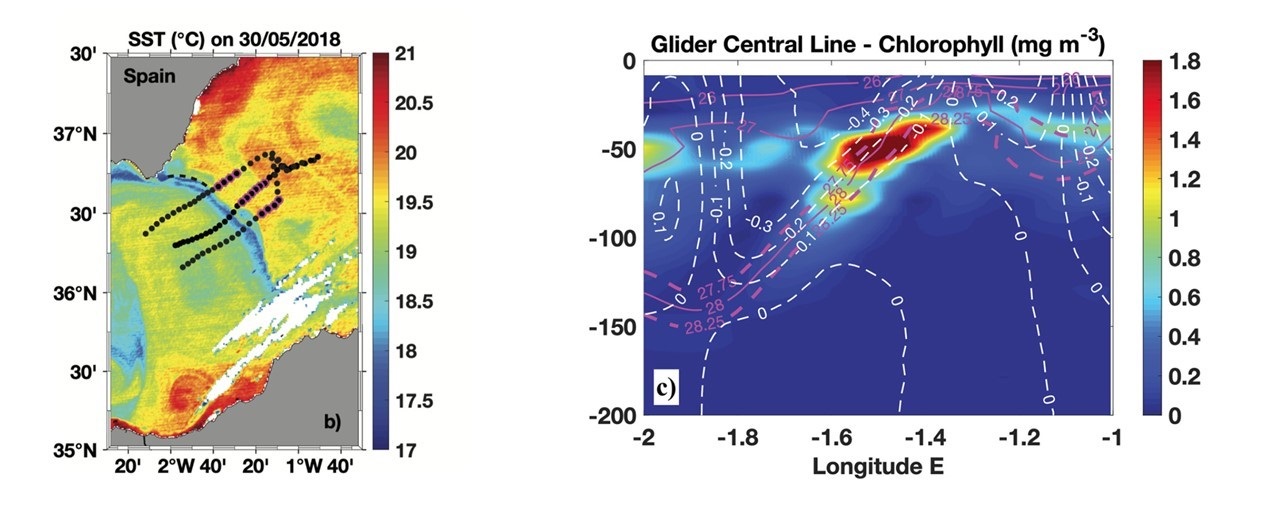New discoveries in understanding the role of 3D pathways in the vertical transport from the surface to the interior
Research teams from the Balearic Islands Coastal Observing and Forecasting System (SOCIB) and the Mediterranean Institute for Advanced Studies (IMEDEA, CSIC-UIB), in Spain, and the Scripps Institution of Oceanography, the Woods Hole Oceanographic Institution and the Massachusetts Institute of Technology, in the United States, have published a series of peer-reviewed articles in the framework of the CALYPSO research program.
Through this international collaboration, the scientists have investigated the three-dimensional pathways and their role in supplying nutrients to the euphotic zone and transporting heat and carbon from the surface to the interior. In the Alboran Sea (Western Mediterranean) as an ideal test basin, and using glider observations, drifters and remote sensing data combined with high-resolution modelling they have studied how water from the surface ocean into the deeper ocean and understand the temporal evolution of the vertical exchanges in the Almeria-Oran front. Scientists have used in-situ observations including measurements from a fleet of underwater gliders deployed in the framework of the CALYPSO 2018 and 2019 experiments in the Alboran Sea. In addition, the high-resolution WMOP model simulations have allowed us to carefully analyze the processes responsible for vertical velocity development in the two main frontal areas of the Alboran Sea. Finally, the research teams have also used 400m-resolution simulations to understand the behaviour of drifters at different depths so as to help explore the reliability of the lagrangian estimates deduced from real drifter data.

The CALYPSO program (Coherent Lagrangian Pathways from the Surface Ocean to Interior) is a United States Office of Naval Research (ONR) Departmental Research Initiative that aims to improve the characterization, understanding and prediction of three-dimensional transports of heat, nutrients, chlorophyll, carbon and oxygen in the ocean.
Related articles
- Zarokanellos, N. D., Rudnick, D. L., Garcia-Jove, M., Mourre, B., Ruiz, S., Pascual, A., & Tintoré, J. (2022). Frontal dynamics in the Alboran Sea: 1. Coherent 3D pathways at the Almeria-Oran front using underwater glider observations. Journal of Geophysical Research: Oceans, 127, e2021JC017405. https://doi.org/10.1029/2021JC017405
- Garcia-Jove, M., Mourre, B., Zarokanellos, N. D., Lermusiaux, P. F. J., Rudnick, D. L., & Tintoré, J. (2022). Frontal dynamics in the Alboran Sea: 2. Processes for vertical velocities development. Journal of Geophysical Research: Oceans, 127, e2021JC017428. https://doi.org/10.1029/2021JC017428
- Rudnick, D. L., Zarokanellos, N. D., & Tintoré, J. (2022). A Four-Dimensional Survey of the Almeria–Oran Front by Underwater Gliders: Tracers and Circulation, Journal of Physical Oceanography, 52(2), 225-242.https://doi.org/10.1175/JPO-D-21-0181.1
- Rypina I., T. R. Getscher, L. J. Pratt and B. Mourre (2021). Observing and Quantifying Ocean Flow Properties Using Drifters with Drogues at Different Depths. Journal of Physical Oceanography, 51 (8), 2463–2482, https://doi.org/10.1175/JPO-D-20-0291.1







